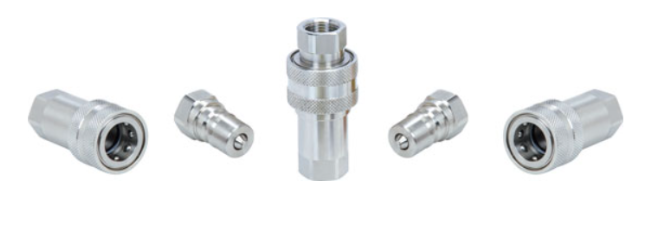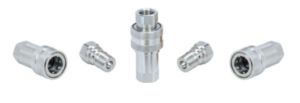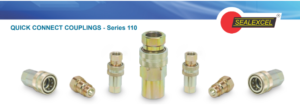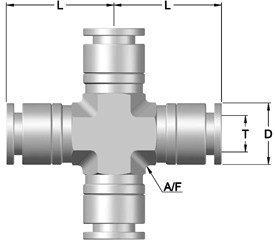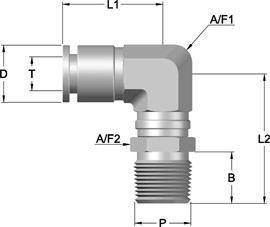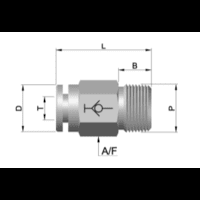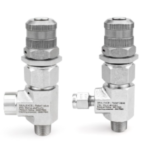
The Ultimate Guide to Pressure Relief Valves: Functions and Types
November 21, 2023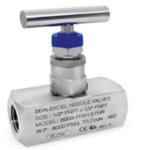
Understanding Needle Valve : Function and Applications
November 23, 2023Quick Connect Couplings Explained: Mastering Fluid Systems
Fluid systems lie at the heart of numerous industries, enabling the transfer and control of liquids or gases within various applications. Whether in manufacturing, automotive, healthcare, or aerospace, the efficiency of fluid systems is paramount. Among the crucial components enhancing this efficiency are Quick Connect Couplings (QCCs). In this comprehensive guide, we’ll delve into the world of QCCs, uncovering their mechanisms, applications, benefits, and considerations for mastering fluid systems.
Understanding Quick Connect Couplings
Quick Connect Couplings, also known as Quick Disconnect or Quick Release Couplings, are ingenious devices designed to swiftly connect and disconnect fluid lines without compromising safety or integrity. These couplings come in diverse configurations, materials, and sizes to accommodate an array of applications.
Mechanics Behind Quick Connect Couplings
- Push-to-Connect: One of the most common mechanisms involves a push-to-connect system, where inserting the plug into the socket initiates automatic engagement and sealing. This allows for effortless and speedy coupling.
- Twist-to-Connect: Another variation involves a twist-to-connect mechanism. Here, the plug is inserted into the socket and then twisted to secure the connection, ensuring a leak-free junction.
Benefits of Quick Connect Couplings
- Time Efficiency: Rapid connections and disconnections significantly reduce downtime during system maintenance or reconfiguration.
- Versatility: With compatibility across various fluids and gases, QCCs offer flexibility in application.
- Safety: The robust design of QCCs ensures secure connections, minimizing the risk of leaks or spills.
- Cost-effectiveness: The time saved in labor and maintenance translates to cost savings in the long run.
Considerations When Choosing Quick Connect Couplings
- Material Compatibility: Ensure that the materials used in the QCCs are compatible with the fluids or gases being transferred to prevent corrosion or contamination.
- Pressure and Temperature Ratings: Assess the operating conditions and choose QCCs that can withstand the specified pressure and temperature ranges.
- Connection Size and Type: Select the appropriate size and type of coupling to ensure a snug fit and efficient fluid transfer.
- Environmental Conditions: Consider the environment where the QCCs will be utilized, such as exposure to chemicals, UV rays, or extreme temperatures.
What is the male part of a quick-disconnect coupling?
The male part of a quick-disconnect coupling is a component designed to swiftly and securely connect with its female counterpart in a fluid system. It typically consists of a plug or fitting that inserts into the female socket, enabling rapid coupling and decoupling of fluid lines. This part is characterized by various features depending on the coupling design and application requirements:
- Plug/Fitting: The male part often comprises a plug or fitting with specific dimensions and configurations tailored to match the female socket for a secure connection.
- Connection Mechanism: It includes mechanisms like push-to-connect or twist-to-connect, allowing for quick and reliable engagement with the female coupling.
- Sealing Elements: These parts commonly feature sealing elements, such as O-rings or gaskets, to ensure a leak-free connection and prevent fluid spillage.
- Materials: The male part is constructed from materials compatible with the fluids or gases being transferred, ensuring durability and resistance to corrosion or degradation.
What is the female part of a quick coupling?
The female part of a quick coupling complements the male component, providing the socket or receptacle to receive and connect with the male plug. Key aspects of the female part include:
- Socket/Receptacle: The female part comprises the socket or receptacle designed to receive the male plug, ensuring proper alignment and connection.
- Locking Mechanism: It often incorporates a locking mechanism that securely holds the male plug in place to prevent unintended disconnection during operation.
- Sealing Features: Similar to the male part, the female coupling includes sealing elements to create a tight seal when connected, preventing leaks.
- Compatibility: Like the male part, the female coupling is constructed from materials compatible with the fluids or gases to be transferred, ensuring compatibility and longevity.
Screw to Connect
“Screw to connect” refers to a type of coupling mechanism where the male and female parts are joined by screwing them together. This method involves threading the male part into the female component to establish a secure connection. It’s a reliable and robust way of coupling that provides a strong seal and is commonly used in various applications where a secure, threaded connection is preferred for fluid transfer systems. This method ensures a tight fit, often used in high-pressure or high-temperature environments where a secure connection is crucial for safety and efficiency.
Conclusion
Quick Connect couplings stand as indispensable components within fluid systems, revolutionizing efficiency and functionality across multiple industries. Mastering these couplings involves understanding their mechanisms, identifying suitable applications, reaping their benefits, and considering crucial factors in their selection.
In essence, the adoption of Quick Connect Couplings isn’t merely about connecting fluids—it’s about seamlessly connecting efficiency, safety, and productivity within fluid systems, thereby mastering the art of fluid management in modern industries.

